ADATA XPG V2 2600 MHz RAM Kit
 |
Introduction
As enthusiasts we don’t just want a fast machine, we want the fastest machine. You could get by with a budget processor and some 1866 MHz RAM, but if you had the choice, would you? The answer to that is probably no. We want the fastest processor and enough RAM performance to match.
ADATA has answered that call with their XPG V2 line of performance memory. Available in speeds up to a staggering 3100 MHz, not having enough RAM speed should not be an issue you ever face again.
Today we are taking a look at their slightly less insane, but still crazy, 2x4GB 2600 MHz kit which we will be doubling up and using in quad channel. The idea behind these kits is that they will never hold you back. You have enough headroom to overclock your processor and graphics card and not have to worry about your RAM being a limiter on your system’s performance. Read on to see how well it performs.
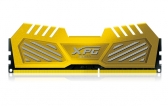 |
 |
Features
- Top of the Line Performance – DDR3 speeds up to 3100 MHz, with timings of CL 12-14-14-36 at 1.65V (XMP Profile 1), provide the muscle needed to run the most demanding games and software. The ADATA XPG V2 Series is comprised of an extruded heat sink with increased surface area, providing superior thermo-conductivity, efficiently reducing power consumption and greatly elevating signal completion. An industry-leading 2oz double-copper PCB increases module stability.
- The Highest Standard for Stability and Efficiency – ADATA XPG V2 memory products are made in conformation with JEDEC regulations and DDR3-1333 standards at CL value of 9-9-9-24 . Each XPG V2 memory chip is selected through a strict filtering process, complete with high-quality PCBs (Printed Circuit Board) and an aluminum heat sink that effectively lowers module temperature, proven to reach a maximum speed of 3100MHz at CL value 12-14-14-36 to make complete use of the computer’s power.
- Advanced Heatsink Design for Better Cooling Efficiency – Using Thermal Conductive Technology (TCT) and 2oz Copper 8-layer PCB, the specialized heat sink ensures outstanding stability even when systems are pushed to the limit.
Specifications
| Speed | Size | Latency | Voltage |
| DDR3-3100 | 4GB x 2 | CL12-14-14-36 | 1.65V |
| DDR3-3000 | 4GB x 2 | CL12-14-14-36 | 1.65V |
| DDR3-2933 | 4GB x 2 | CL12-14-14-36 | 1.65V |
| DDR3-2800 | 4GB x 2 8GB x 2 |
CL12-14-14-36 | 1.65V |
| DDR3-2600 | 4GB x 2 8GB x 2 |
CL11-13-13-35 | 1.65V |
| DDR3-2400 | 4GB x 2 8GB x 2 |
CL11-13-13-35 | 1.65V |
| DDR3-1600 | 4GB x 2 8GB x 2 |
CL9-9-9-24 | 1.50V |
Packaging
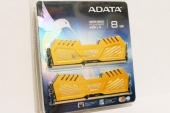 |
The XPG V2’s packaging is nothing fancy, just your standard blister pack which thankfully has a nice perforation along the back for easy opening.
 |
Closer Look
 |
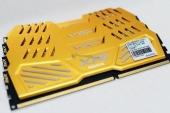 |
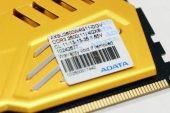 |
ADATA sent us the gold XPG’s, although they also come in tungsten grey. The aluminum heatsink is not overly large but could still potentially cause issues with some of the larger air coolers.
As you can see from the sticker, this is DDR3 at 2600 MHz with timing set to 11-13-13-35 at 1.65V which are respectable numbers compared to the competition.
Test System
- Intel Core i7-4960X CPU
- ASUS P9X79-E WS Motherboard
- Sapphire R9 290X Tri-X GPU
- ADATA SX900 128GB SSD
- NZXT Phantom 410 Case
- Corsair H100 CPU Cooler
- Thermaltake Toughpower 1350W PSU
Benchmarks
 |
Before we get to the benchmarks we need to talk about a pretty significant issue that we experienced. Like any other RAM, we popped it in the slots, entered the BIOS, and enabled the XMP profile. The problem here is that because this RAM is 2600 MHz and not 2666 like the vast majority of the competition, you have to play with straps and adjusting the base clock to get to 2600. By default the XMP profile set the strap to 125 and the base clock to 121.875 which means that you have to manually adjust your core ratios or else you are going to be booting with a overclock on the CPU.
The main problem came when running benchmarks. All of the scores were significantly lower than they should be. I tried disabling XMP and tuning it manually with different straps and base clocks and even overclocking it slightly to 2666 (which it wouldn’t do without extra voltage), all of which either made no difference or weren’t stable. The only option was to downclock it to 2400 and run the tests there (since 2400 doesn’t require playing with straps/BCLK).
AIDA64
AIDA64 Extreme Edition is a streamlined Windows diagnostic and benchmarking software which provides a wide range of features designed to assess the performance of the processor, system memory, and disk drives.
For our purposes today, AIDA64 is used to test the read, write, copy, and latency of our ADATA XPG 2600 MHz RAM, and compare it to the competition.
 |
 |
Starting off with the read and write tests our RAM pulled over 53,000 MB/s, only being beat by the highest-end server machines.
In the write test though we scored quite a bit lower, only a little over 41,000 MB/s, and getting bested by the high-end desktop machines.
 |
 |
Moving on to the copy and latency tests, the XPG kit scored 53,560 MB/s, putting it right behind the servers again, and 61.9 ns.
Memtach
MemTach is a benchmark based on memset and memcpy are functions from the C programming language. These functions are used to set the contents of a block of memory and copy the contents of a block of memory to another block. Although this benchmark tool is older, we can still pull some good information from it.
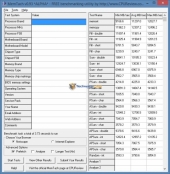 |
Our ADATA kit averaged 11,297 MB/sec in memset and 12,307 MB/sec in memcpy with a total run-time of 3.73 seconds.
Performance Test 8
PerformanceTest v7.0 provides an all in one benchmark for testing all components and subsystems of the test setup. For our purposes we will take a look at the detailed memory performance test results.
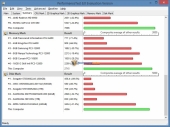 |
As we can see here, our 2600 MHz kit blew away the lower clocked competition with a score of 2715.
SiSoft Sandra
Lastly, we will go to the SiSoft Sandra benchmark which is another all-in-one tool capable of testing virtually every part of the machine. We are going to focus on two tests in particular though, memory bandwidth and latency.
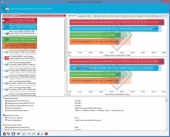 |
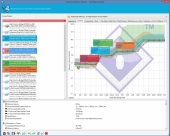 |
In the bandwidth test, our ADATA kit beat out even the highest-end competition with a throughput of 48.121 GB/s.
Our latency came out to 24 ns, narrowly getting beat out by one other system.
 |
Final Thoughts
All in all, I wasn’t very pleased with the ADATA XPG V2 2600 MHz kit. Although the performance was quite impressive, it’s fairly low profile, and it looks pretty good, the fact that it is clocked at such a strange speed means that you have to play with the base clock which is a very tricky situation and can cause problems for other components. The XMP profile caused problems on our setup right away, giving benchmark scores much lower than expected which didn’t go away at all until the speed was dropped down to 2400. Even at 2400 MHz though this kit was able to beat out all but the highest-end server machines. But considering the issues and the minor performance gain you are bound to get by increasing speed, you would probably be better off just going with the 2400 MHz kit.

[…] ADATA XPG V2 2600 MHz RAM Review at TechwareLabs.com […]